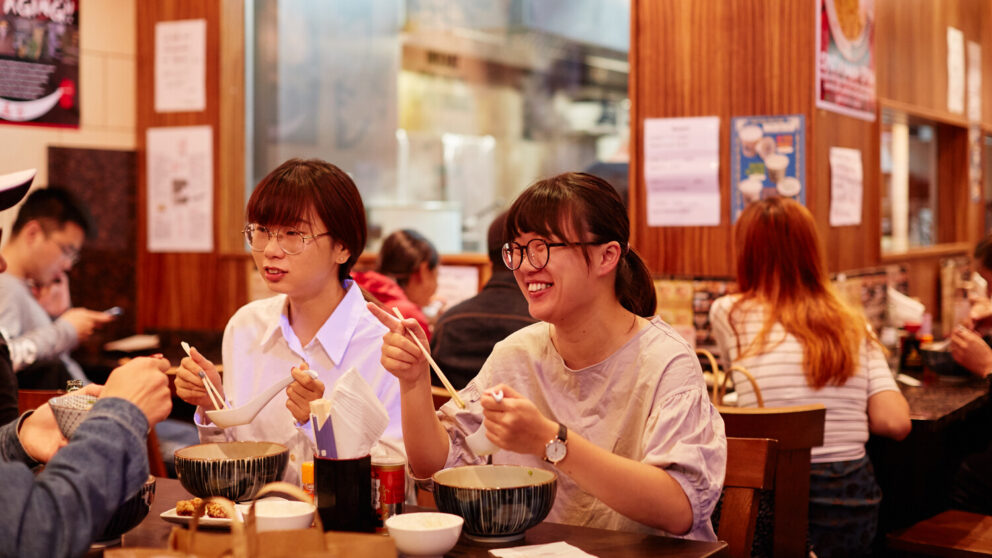
Chopsticks, wasabi and soy sauce: a primer in sushi etiquette
Chopsticks, wasabi and soy sauce: a primer in sushi etiquette
Not difficult at all - and yet of great importance: How to taste your favorite food correctly without upsetting your hosts or spoiling the taste.
Even if we don't like to hear some proverbs anymore - there seems to be some truth in many of them. The best example? "Less is more!" This is especially true for one of our - and perhaps your - favorite cuisines, namely Japanese, which we in Düsseldorf are more than blessed with thanks to the Japanese community. "The less cooked, the better cooked," is a long-established Japanese saying. And what better specialty could it apply to than, that's right, sushi! The fact that we usually eat the fish used for it raw is considered common knowledge. But how well are you initiated into the secrets of correct sushi consumption? Even if it doesn't seem that difficult to enjoy, there are a few "handling" rules to follow - not only so as not to upset the hosts in a Japanese restaurant, but also so as not to adulterate the taste of the dish. In the following, you will learn in six points what is important.
Fish, fish and agains Fish
Vegetarian or even vegan sushi with avocado, egg or cucumber? You won't find any in Japan. After all, the sea is no further than 150 kilometers away at any point in the country. And that has to be used! Aspiring chefs have to spend at least five years in training before they are able to prepare sushi according to all the rules of the art. If they want to prepare the extremely poisonous puffer fish, the training is extended by another five years. Traditionally, the Japanese understand the preparation of the dish as a purely male matter, women allegedly have hands that are too warm to form sticky rice. But that's just a little information in advance.
Another custom, and this brings us back to the beginning of this section and the first golden rule: Never order "traditional sushi" and then on top of that, for example, inside-out rolls with cream cheese. These are creations invented in the USA. Authentic sushi includes only the following types: maki (fish wrapped in rice in a toasted seaweed sheet), nigiri (a bed of rice with a slice of fish on top) and sashimi (raw fish eaten plain).
Bye-bye, cutlery!
It may sound familiar, but you won't find a knife or fork in Japanese restaurants. Instead, the correct eating of your sushi requires the use of wooden chopsticks ("Hashi" in Japanese) - or, more rarely, porcelain. The tool is said to have found its way to Japan from China as early as 500 AD. How does it work? You hold one chopstick between your middle and ring finger without it moving, and the other works against it with your thumb and index finger while you pick up the rolls. Sounds complicated, but with a little practice it works without a problem. Eaten (almost) everything? Then put the chopsticks back on the small bench ("Hashioki"). Do not put them - most unwelcome - in the last roll or lay them across the plate or bowl. This is a ritual of the dead.
The appetizers just won't hold despite all your efforts? Nevertheless, do not ask for cutlery - this is considered an insult to the sushi chef, because it means that the rolls seem unsuitable for simple consumption. Alternatively - and in keeping with the style - simply eat with your fingers. This is considered rather indelicate in Germany, but in Japan women, men and children often enjoy their sushi in the same way, especially since it is often on sale at markets there.
Oh, and while we're on the subject of cutlery: The miso soup often served with sushi is simply drunk from the bowl. So long, spoon.
Always nicely in order
Your head is already spinning from all the rules? No need to despair, after all, even a minor misstep won't get you expelled from the restaurant. It's more about showing mutual appreciation for the cuisine and eating etiquette of the other culture. Especially since the following point is less about "correct" or "not correct" and more about a recommendation. After all, the order of the sushi helps determine the taste experience. Therefore note: Many Japanese* start their menu by eating a light, white fish, followed by a pink one. This is followed by the consumption of fattier red fish such as tuna. Fatty fish like salmon closes the meal. Not unusual: the miso soup served only at the end.
Dipping, but correctly
There are many legends about when sushi first became popular. One says that it became very popular in Edo, now Tokyo, at the beginning of the 19th century. It is considered fairly certain that the sauce served with the specialty originated in Zhou Dynasty China. Wondering what could go wrong with the dark liquid made from fermented soybeans, wheat grains and salt? Actually, not much at all, but a few missteps can sometimes lead to great harm. For example, never dip nigiri sushi with the rice first into the sauce, because the grains absorb too much of the distinctive liquid, distorting the flavor of the fresh fish or vegetables. Maki rolls are dipped into the sauce from the side.
Also a faux pas that many of us in Germany like to commit, but unknowingly: Mixing wasabi into the soy sauce. The liquid, which is often aged for years, enjoys a special status in Japan, and correspondingly little of it is used. So here, too, the rule is: less is definitely more. By the way, you can buy a variety of soy sauces with different flavors at the Shochiku supermarket at Immermannstrasse 15, and at Maruyasu, just a few doors down (Immermannstrasse 11), you can buy an excellent version brewed especially for the restaurant to take home for a few euros.
Everything is gone in one bite
What may seem greedy to you at first, corresponds absolutely to the ideas of Japanese people: They always eat their sushi whole, i.e. without biting it off. Only in the case of large rolls with several components ("futomaki") is the task more difficult, which is why it is perfectly acceptable to eat in two steps - with the rest being eaten in one bite. The take-away is often served in one go (green tea, white wine and lager go equally well with the dish). You can also enjoy the often served take-shot in one go (green tea, white wine and pilsner go equally well with the dish).
If you can't decide between all the choices of sushi variations - "huromaki" (with only one type), "chumaki" with several components and said "futomaki" - let the chef or sushi master decide. The process is called "domakase".
Ginger/ Wasabi
No sushi without ginger and wasabi! Strictly considered only supporting actors, they belong for many of us indispensable to the feast. But, you guessed it: Here, too, mishaps lurk. Keyword soy sauce: Mixing the wasabi paste in soy sauce is a no-go (as mentioned, a lot of time and work goes into the preparation of the sauce, so it should remain as pure as possible). It is better to add the spicy radish directly to the sushi and dip both together in the liquid. In good restaurants, the sushi masters often work the wasabi into the rolls.
What is true of wasabi is not true of ginger ("gari"): if at all possible, do not put the ingredient on the sushi; it does not traditionally belong there. Rather, eaten pure, it serves as a kind of intermediate course to finely separate the taste of the different types of fish from the other.
Title image: Düsseldorf Tourism



